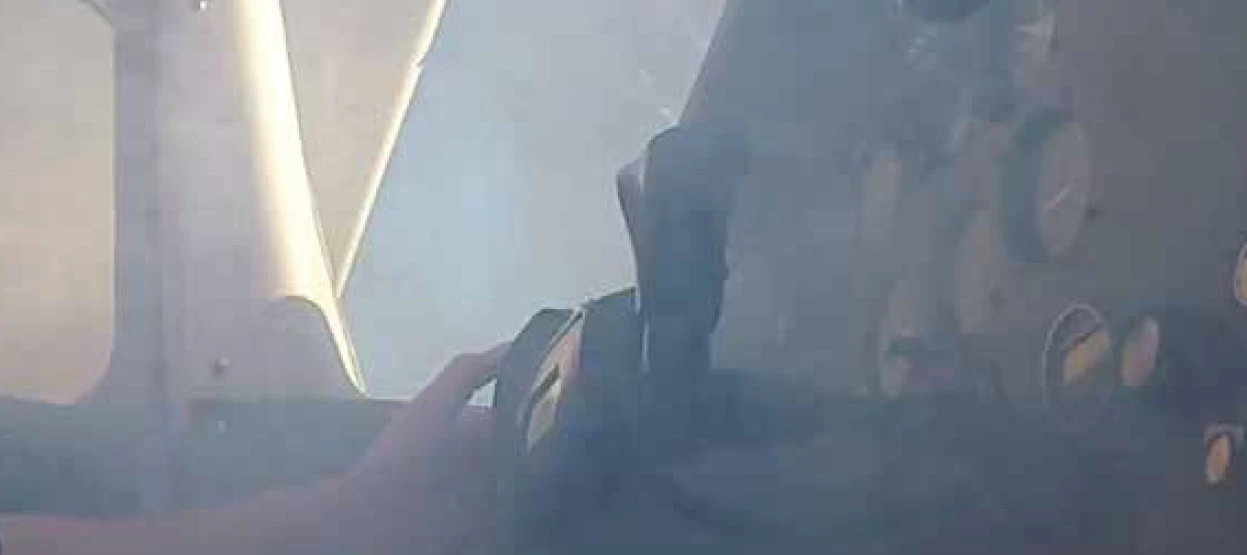Electric Trim Runaway, Strong Burning Smell, Smoke, or Fire in the Cockpit
Once confirmed, immediate action is required: turn the aircraft’s main electrical master switch OFF. We all know where to find that switch quickly. This action isolates approximately 99% of the aircraft’s electrical power — the power supplied to the main and avionics bus bars, from which most onboard systems draw current, including those protected by circuit breakers and remote fuse holders.
The only power not isolated is the battery-direct “hot” power, which is supplied via a fuse to maintain avionic memory, clocks, entry lights, and — in some Beech models — the stall warning system. Isolating the electrical system via the master switch gives you the fastest and best chance to prevent a potentially out-of-control situation if the problem is electrical in origin.
With the master switch off, engines with magnetos will continue to run. Vacuum and pitot-static instruments will remain operational. EFIS systems with battery backup will continue working, and so will basic instruments like thermocouples, Bowden tubes, direct-reading pressure gauges, mechanical tachometers, magnetic compasses, EGTs, CHTs, oil temp and pressure gauges, fuel flow indicators, and float-type fuel gauges.
However, the following will not function: electrical autopilots and trim systems, electric tachos, oil temp and pressure gauges (if electrically driven), radios, and instrument lighting.
Once the master switch is turned off, you regain time and clarity to assess the situation. For example, if you saw smoke, where was it coming from? The right-hand side of the panel? The avionics stack? If it was an electric trim runaway, you can now locate and isolate the trim circuit breaker or master switch. If it was a bad burning smell, like a blown capacitor in an avionics unit, check whether the smell is subsiding.
If the situation improves with the master switch off and you suspect the avionics, turn off the avionics master switch or, if unavailable, power off each unit individually. Once isolated, you may turn the master switch back on (with avionics still off) and monitor for recurrence. If the smell or smoke does not return, you can narrow it down to an avionics unit. Power them back on one by one until the fault returns. When identified, leave that unit off and isolated. I’ve used this method twice in my flying career — once due to a failed capacitor in a radio, and once due to a voltage-dropping resistor in a cigarette lighter socket being used for a heavier-than-designed load.
If the smoke or smell returns with avionics off, shut off the master switch again. You may then consider isolating other systems via switches or breakers. If you can isolate the issue this way, you may be able to continue the flight safely. If the problem cannot be isolated except through switching off the master switch entirely, assess your situation. Can you switch from IFR to VFR and land as soon as possible? Can you make it to a safe maintenance base, or should you divert to the nearest safe airfield?
A high percentage of cockpit and airframe fires are electrical in nature. Turning off the master switch often eliminates the problem. However, in rare but serious cases, electrical wiring can chafe into rigid aluminium fluid lines that carry flammable fuel or engine oil — especially those leading to panel-mounted gauges or combustion heaters. In such a scenario, arcing can ignite leaking fluid. Turning off the master switch alone may not stop the fire if a flammable liquid is already exposed.
In that case, turn off the master switch and immediately shut off fuel supply via the fuel selector or shutoff valve (and in twins, the heater fuel valve). Once engines stop due to fuel starvation, if the fire continues, feather the engines (in twins) or, in singles, raise the nose to stop the prop windmilling and pumping oil.
In my opinion, it is vital to turn off the master switch immediately, followed by fuel shutoff in the event of an explosive fire. These actions give you the best chance of reducing the fire and buying enough time to land safely.
The same procedures apply to engine compartment fires. The safest way to descend rapidly without overspeeding (which can intensify a fire) is to enter a full side-slip with maximum rudder deflection, and lower wing flaps and landing gear (if manually operable).
Fires can burn through aircraft structure in seconds — smart, precise, immediate action is critical to survival. Sadly, I am aware of two recent fatalities in Australia and six in the U.S. due to cockpit or engine fires in piston aircraft. These tragedies underscore the importance of attention to detail during maintenance, particularly in avionics, engine, and instrument installations. Independent checks and proper inspections help minimise risk.
So remember:
• Master switch OFF immediately
• Fuel OFF if required
• Stop the engine windmilling (if needed)
• Use a fire extinguisher if available — though be aware it may cause temporary visibility loss in the cockpit
Sorry for the sombre subject — but if this information ever helps bring someone safely back to the ground, it will have been worth sharing.
Tony Brand
Director / Chief Engineer
Horsham Aviation Services

